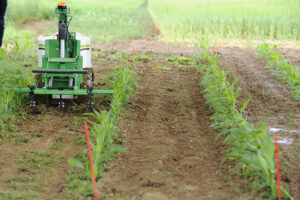Weeds to drag down corn yields in the future

University of Illinois scientists analysed how climate change in combination with late-season weeds effects corn yields. The results are quite alarming: the study shows an average of 50% loss in corn yield.
Climate change works two ways, according to a new study by University of Illinois. While climate change alone could reduce corn yields in the U.S. corn belt by up to 28% by the end of this century, those same weather conditions benefit weeds that thrive in tough – hot and dry – conditions.
Herbicides less effective
Also, herbicides are becoming less effective – especially with waterhemp and Palmer amaranth – and new classes of herbicides in corn are not to be expected in the short term.
According to Marty Williams, USDA-Agricultural Research Service ecologist, affiliate professor in the Department of Crop Sciences at Illinois, and co-author on a new study in Global Change Biology, computer models projecting corn yields into the future are assuming weed-free conditions. And that’s unlikely to be the case, at least without a major transformation in the way farmers manage weeds, said Williams.
27 years of herbicide evaluation trials

A team of scientists analysed 27 years of herbicide evaluation trials representing more than 200 unique weather environments throughout the state of Illinois. They looked at crop management considerations, including planting date, hybrid choice, and planting density; percent weed control for multiple weed species; weather data at key growth stages throughout the corn life cycle; and yield.
The analysis showed an average of 50% yield loss in corn when late-season weeds were minimally controlled. Even with relatively robust late-season weed control (up to 93%), weeds exacerbated crop losses in hot or dry conditions.
Also read: Ag-tech investments in a climate conundrum
Herbicide efficacy is also dampened by climate change, according to the scientists. Pre-emergence herbicides are less effective when a period of drought sets in after application. The study also shows that if a farmer is forced to plant later due to wet conditions in spring, yield loss could be 18% less when corn was planted after April 29. However, planting later may benefit weed management, but it could expose the crop to greater risk of drought during reproduction, Williams said.
Robotic weeders
According to Williams, new herbicides will “not be a silver bullet”. We do need new tools, he said. “Whether that’s harvest weed seed control, genetic engineering approaches, robotic weeders, or another advancement. As new tools become available, we need to diversify how weeds are managed. Not just with registered herbicides, but all available tactics.”
Join 17,000+ subscribers
Subscribe to our newsletter to stay updated about all the need-to-know content in the agricultural sector, two times a week.



